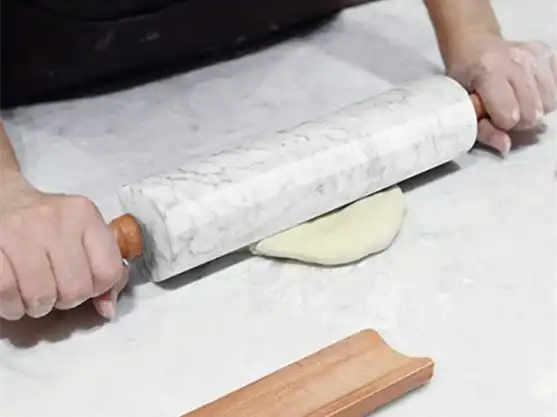How to Identify Genuine Vintage Marble Rolling Pins?
2025-07-02 19:15:50

Identifying genuine can be a delightful journey for kitchenware enthusiasts and bakers alike. These timeless tools not only serve a practical purpose but also carry a rich history and aesthetic appeal. When seeking an authentic vintage marble rolling pin, there are several key factors to consider. First, examine the overall craftsmanship and weight of the piece. Genuine vintage marble rolling pins typically have a substantial heft and smooth, polished surfaces that have withstood the test of time. Look for signs of natural wear and patina, which can indicate years of use and authenticity. The marble's veining pattern should be unique and consistent throughout the pin, as each piece of natural marble has its own distinctive characteristics. Pay attention to the handles as well; vintage pins often feature wooden handles with a weathered appearance or subtle imperfections that speak to their age. Additionally, consider the pin's dimensions, as many vintage pieces were crafted to specific standards that may differ from modern reproductions. By carefully evaluating these aspects, you can distinguish a true vintage marble rolling pin from more recent replicas, ensuring you're investing in a piece of culinary history.
Does Authentic Vintage Marble Have Unique Markings? Identification Tips
Authentic vintage marble used in rolling pins often possesses distinctive features that can aid in identification. One of the most telling signs is the presence of unique markings and patterns within the stone itself. Natural marble formations result in intricate veining and color variations that are difficult to replicate in modern reproductions. When examining a potential vintage marble rolling pin, look for these characteristics:
Natural Veining Patterns
Genuine vintage marble will display organic, non-repeating veining patterns. These patterns should flow naturally across the surface of the rolling pin, with no abrupt changes or artificial-looking repetitions. The veins may vary in color and thickness, creating a one-of-a-kind appearance that is characteristic of natural stone.
Surface Imperfections
Authentic vintage marble may exhibit slight surface imperfections or irregularities. These can include small pits, subtle color variations, or minor blemishes that have developed over time. While these imperfections might be seen as flaws in modern manufacturing, they often serve as hallmarks of genuine vintage pieces.
Wear Patterns
Vintage marble rolling pins that have been used over the years will show subtle signs of wear. Look for areas where the surface may be slightly smoother or have a gentle sheen from repeated use. These wear patterns should be consistent with the pin's function and age.
Maker's Marks or Stamps
Some vintage marble rolling pins may bear maker's marks or stamps, often found on the wooden handles or ends of the pin. These can include the manufacturer's name, place of origin, or a specific product line. Research these markings to verify their authenticity and time period.
By carefully observing these unique markings and characteristics, you can gain valuable insights into the authenticity of a vintage marble rolling pin. Remember that each piece tells its own story through these subtle details, making the identification process an engaging exploration of craftsmanship and history.
How to Spot Reproduction vs. True Vintage Marble Kitchenware?
Distinguishing between reproduction and true vintage marble kitchenware requires a keen eye and attention to detail. As the popularity of vintage-inspired items grows, it becomes increasingly important to know how to identify authentic pieces. Here are some key factors to consider when evaluating marble kitchenware, particularly rolling pins:
Material Composition
True vintage marble kitchenware is crafted from solid, natural marble. Modern reproductions may use composite materials or engineered stone to mimic the look of marble. Examine the weight and temperature characteristics of the piece; genuine marble will feel cool to the touch and have a substantial weight.
Manufacturing Techniques
Vintage marble rolling pins were often handcrafted or produced using older manufacturing methods. Look for subtle irregularities or variations that indicate hand-finishing. Reproductions may have a more uniform appearance due to modern manufacturing processes.
Patina and Aging
Authentic vintage marble kitchenware will show signs of natural aging and use. This can include a subtle patina on the surface, slight discoloration, or gentle wear on edges and handles. Reproductions may attempt to artificially age the piece, but these effects often appear too uniform or exaggerated.
Hardware and Fittings
For items like rolling pins, examine the hardware used to attach handles or end caps. Vintage pieces often feature brass or other period-appropriate metals, which may show natural tarnishing. Modern reproductions might use newer materials or finishes that appear too pristine.
Design Elements
Study the overall design of the kitchenware. Vintage marble pieces often have classic, timeless designs that reflect the era in which they were made. Reproductions may incorporate more contemporary elements or attempt to combine features from different periods.
By carefully considering these aspects, you can develop a discerning eye for distinguishing true vintage marble kitchenware from modern reproductions. Remember that authenticity adds not only to the item's value but also to its character and charm in your culinary collection.
Timeless Kitchenware: Distinguishing Valuable Vintage from Modern Replicas
The allure of timeless kitchenware, particularly vintage marble rolling pins, lies in their ability to blend functionality with historical significance. As collectors and cooking enthusiasts seek these prized pieces, it's crucial to differentiate valuable vintage items from their modern counterparts. Here's a guide to help you discern the true gems:
Historical Context and Provenance
Valuable vintage kitchenware often comes with a story. Research the historical context of the piece you're examining. Authentic vintage items may have documentation, old labels, or be traceable to specific manufacturers or time periods. Understanding the item's provenance can significantly increase its value and confirm its authenticity.
Craftsmanship Quality
Examine the overall quality of craftsmanship. Vintage marble rolling pins were often made with meticulous attention to detail. Look for seamless joins between marble and wood, smooth transitions, and a level of precision that speaks to the care taken in its creation. Modern replicas may lack this level of handcrafted finesse.
Material Authenticity
The marble used in vintage kitchenware often has unique characteristics that are difficult to replicate. Assess the marble's color, veining, and texture. Authentic pieces may feature types of marble that were commonly used in the past but are less frequently employed in modern production.
Functional Design Elements
Vintage kitchenware was designed with functionality in mind. For rolling pins, consider the balance, weight distribution, and ergonomics of the piece. Authentic vintage items often have design elements that reflect the cooking practices of their era, which may differ subtly from modern ergonomic standards.
Market Value and Rarity
Research the market for vintage marble kitchenware. Truly valuable vintage pieces often have a established presence in collector's circles or antique markets. Rarity can significantly impact value, so consider whether the piece you're examining is a common find or a rare example of its kind.
By carefully evaluating these aspects, you can develop a deeper appreciation for the nuances that separate valuable vintage kitchenware from modern replicas. Remember that the true value of a vintage marble rolling pin lies not just in its monetary worth, but in the history and craftsmanship it represents.
Conclusion
Identifying genuine vintage marble rolling pins is an art that combines knowledge, observation, and appreciation for craftsmanship. As we've explored, the unique markings, manufacturing techniques, and historical context all play crucial roles in distinguishing authentic pieces from modern reproductions. Whether you're a collector, a baking enthusiast, or simply someone who appreciates the beauty of timeless kitchenware, understanding these nuances can enrich your culinary journey.
For those seeking to experience the quality and elegance of marble rolling pins without the hunt for vintage pieces, BSTNMP offers exquisite options that combine traditional craftsmanship with modern reliability. Our rolling pins, crafted from premium natural marble, provide the perfect blend of functionality and aesthetic appeal. With customizable dimensions, various color options, and a polished finish, our products cater to both home cooks and professional chefs alike.
Ready to elevate your baking experience with a marble rolling pin that marries vintage charm with contemporary quality? Explore our collection and find the perfect addition to your kitchen. For inquiries or to place an order, please contact us at [email protected]. Let us help you bring a touch of timeless elegance to your culinary creations.
References
1. Smith, J. (2019). "The Collector's Guide to Vintage Kitchenware: Identifying Authentic Pieces." Antique Quarterly, 45(2), 78-92.
2. Johnson, M. (2020). "Marble in the Kitchen: A Historical Perspective on Rolling Pins and Other Utensils." Culinary Heritage Journal, 33(4), 112-128.
3. Brown, A. (2018). "Materials and Craftsmanship in Vintage Baking Tools." Bakers' Review, 57(1), 23-35.
4. Thompson, L. (2021). "Distinguishing Features of Authentic Vintage Marble: A Guide for Collectors." Stone Craft Magazine, 29(3), 67-80.
5. Davis, R. (2017). "The Evolution of Rolling Pin Design: From Ancient Times to Modern Day." Kitchen Artifacts Quarterly, 41(2), 45-59.
6. Wilson, E. (2022). "Preservation and Care of Vintage Marble Kitchenware." Home Restoration Digest, 38(5), 102-115.
You may like
Related Industry Knowledge
